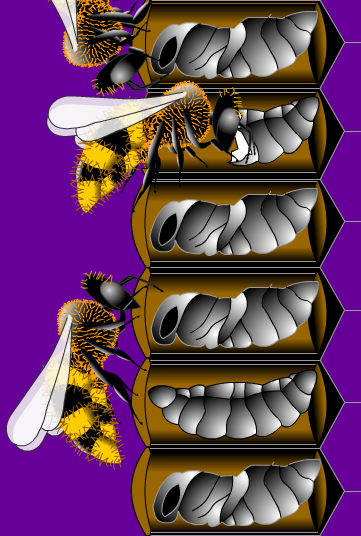Our Research
We began breeding honey bees for resistance to diseases and V. destructor in 1994. Honey bees bred for hygienic behavior, a genetic trait, demonstrate behavioral resistance to American foulbrood (AFB), a highly infectious bacterial disease of brood (larvae). Hygienic honey bee colonies also demonstrate resistance to chalkbrood, a fungal disease (Spivak and Reuter, 2001a). Bees bred for hygienic behavior can detect and physically remove disease-infected brood from the colony before it becomes infectious. Hygienic bees can in fact detect and remove diseased brood before the human eye can detect any sign of disease symptoms! When bees remove the disease in the non-infectious stage, it prevents the disease from spreading throughout the colony.

Our research has shown that bees bred for hygienic behavior also display one form of resistance to Varroa destructor mites because they are able to detect and remove brood infested with the mites (Spivak, 1996). This mite parasite alternates between feeding on adult bees and feeding and reproducing on the pupal stage of bees. Bees that remove mite-infested pupae from the nest interrupt the reproductive cycle of the mite and eliminate the offspring of the mite developing within a wax-sealed cell (Figure 1).
We initially selected for hygienic behavior in an Italian-derived race of honey bees. However, the behavior is present in all races and stocks of Apis mellifera in the United States (and the world), and can be easily selected for using the methods described below. We bred the “MN Hygienic Line” of bees, which became widely accepted by the beekeeping industry. Much of our early research effort was devoted to evaluating the MN Hygienic Line against other lines of commercially available honey bees to ensure that it is resistant to diseases and can actively defend itself against the mite pests, resulting in lower mite levels. We also evaluated the honey production, gentleness and wintering ability of our line to ensure that it is acceptable to both commercial and hobbyist beekeepers (Spivak and Reuter, 1998a; 2001b).
In line with our second goal of ensuring that our selection methods are accessible to beekeepers everywhere, we stopped maintaining the MN Hygienic Line at the University of Minnesota in 2009 and began working with commercial queen producers to help them select for hygienic behaviors from among their favorite stocks of honey bee, whether derived from Carniolan, Italian, Caucasian or a mixture of races. Our hope was that beekeepers would make a number of resistant lines available within the United States to maintain genetic diversity: the perfect way to promote the vitality of our pollinators. Today, many large-scale queen producers routinely select for hygienic behavior using the assay described below.
